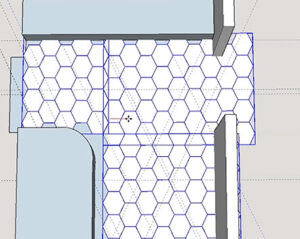10 DIY Tiling Tips to Tile Like a Pro!
Tackling a tile installation job in your home is one of those projects many homeowners steer clear of. While installing tile on your own can be a little tricky, once you’ve done it a few times, have the right tools, and a little bit of confidence, it’s a great skillset you can add to your arsenal. That’s why this week I’ve teamed up with Kobalt Tools to share 10 DIY Tiling Tips to Tile Like a Pro! Follow along with all my tips in the video above or feel free to scroll through them all down below!
For more tips from a Tile Professional, check out my interview with Professional Tile Setter, Adam Esparza of Ale Tile Co.
This project contains a paid product integration from Kobalt Tools. All opinions herein are my own. Visit my disclosure page for more information on affiliate and compensation this site accepts.
1.) Get Yourself the Right Tools
To get a quality installation with your tile, you’ll need some basic tools to get started. I recommend that you have the following tools on hand:
- A hammer
- A pencil
- A level
- A Utility Knife
- A drill and paddle mixer for mixing mortar
- Various notched trowels (1/4″, 5/32″, 3/16″ depending on your application
- A rubber grout float and sponge
- Some knee pads
- A clean bucket
- A tile cutter. (A wet tile saw or tile score and snap tool is really useful especially if you’re doing a larger tile project. However, if you can’t find or rent one, you can also use an angle grinder with a diamond cutoff blade, OR a small saw with a diamond blade like this one with a diamond cutoff blade.)
 Thanks to Kobalt Tools for sending over many of the tools you see in this video for to me to put to the test.
Thanks to Kobalt Tools for sending over many of the tools you see in this video for to me to put to the test.
2.) Make sure your Subfloor is Flat and Level
 When doing a tile floor project you’ll want to make sure your floor is flat and level. You can use either a cement backer board, or what is called a dry pack mortar bed to set your tile on. A backer board application is more DIY friendly but creating your own mortar bed allows you to level uneven surfaces. You can also use a self leveling product to adjust your subfloor first and then apply a backer board or other membrane to tile over. You never want to tile directly over wood as wood expands and contracts in moisture and can cause your tile and grout to crack.
When doing a tile floor project you’ll want to make sure your floor is flat and level. You can use either a cement backer board, or what is called a dry pack mortar bed to set your tile on. A backer board application is more DIY friendly but creating your own mortar bed allows you to level uneven surfaces. You can also use a self leveling product to adjust your subfloor first and then apply a backer board or other membrane to tile over. You never want to tile directly over wood as wood expands and contracts in moisture and can cause your tile and grout to crack.
3.) Know the difference between mastic and Thin Set Mortar and when to use each
There are 2 main categories of adhesive to choose from when installing tile.

1.) Mastic:
Commonly sold in stores as “Tile Adhesive”. Mastic is a pre-mixed glue like product and should only be used in primarily dry applications like kitchen backsplashes. Mastic is stickier than mortar so it’s good for vertical wall applications that aren’t exposed to regular moisture. When installing a backsplash with mastic I use a 3/16″ or 5/32” notched trowel to apply mastic to the wall in small working areas, and then press the tile in place on the wall with a grout float to make sure it seats properly. The notches in the trowel help secure the tile and make sure you aren’t over applying too much mastic which will squeeze out and cause problems especially if you’re using small mosaic tiles like these.
2.)Thin-Set Mortar
Thin-set on the other hand can be used in any application and is my primary method for tile installation. Thin set is sold in bags or boxes and is mixed with water to create a peanut butter like paste. I use thinset for all flooring applications, shower and bath enclosures, and any large format tile installs. Keep your notches running in one direction and make sure that your notches are full.
4.) Use Layout Lines
 In older homes, sometimes the rooms aren’t square and it can be difficult to determine how the tile will look when installed. When installing square or rectangular tiles, I like to always reference the longest wall in the room and draw a line down the middle of the room. I usually add at least 1 perpendicular line as well. I reference these lines as I’m installing the tile to make sure the courses are staying straight to the room. Depending how square or out of square the room is, you can also use the Pathagoreon theorem or 3-4-5 rule to create square lines in the room.
In older homes, sometimes the rooms aren’t square and it can be difficult to determine how the tile will look when installed. When installing square or rectangular tiles, I like to always reference the longest wall in the room and draw a line down the middle of the room. I usually add at least 1 perpendicular line as well. I reference these lines as I’m installing the tile to make sure the courses are staying straight to the room. Depending how square or out of square the room is, you can also use the Pathagoreon theorem or 3-4-5 rule to create square lines in the room.
5.) Setting Your First Course Is Most Important
 Installing the first course of tile is the most important to make sure you have a quality install. You can roughly layout tiles in the room to make sure you won’t have sliver cuts at the end as well. I typically like to shift the tile layout so that I have roughly a ½ piece of tile at each wall. Laying out your tile setup in something like Sketchup can also help you determine how to best set your first course. I always like to hide cuts as much as possible outside of the primary eye-line so keeping them along the edge of the room is best in my opinion.
Installing the first course of tile is the most important to make sure you have a quality install. You can roughly layout tiles in the room to make sure you won’t have sliver cuts at the end as well. I typically like to shift the tile layout so that I have roughly a ½ piece of tile at each wall. Laying out your tile setup in something like Sketchup can also help you determine how to best set your first course. I always like to hide cuts as much as possible outside of the primary eye-line so keeping them along the edge of the room is best in my opinion.
6.) Know When to Back Butter
 A large format tile is a tile that is larger than 12″ x 12″. When installing a large format tile like this it’s important to do a technique called back buttering. Back buttering involves adding a thin coat of thinset to the backside of your tile using the flat side of the trowel. Pressing the tile down into the notches of the mortar on the floor or wall will create a full seat for the tile and not allow for air gaps to be created underneath. Air gaps under the tile can lead to cracks or breaks in the tile down the road if something is dropped in that area. In MOST small tile applications like subway tiles, you likely don’t need to back butter the tiles.
A large format tile is a tile that is larger than 12″ x 12″. When installing a large format tile like this it’s important to do a technique called back buttering. Back buttering involves adding a thin coat of thinset to the backside of your tile using the flat side of the trowel. Pressing the tile down into the notches of the mortar on the floor or wall will create a full seat for the tile and not allow for air gaps to be created underneath. Air gaps under the tile can lead to cracks or breaks in the tile down the road if something is dropped in that area. In MOST small tile applications like subway tiles, you likely don’t need to back butter the tiles.
7.) Trim your Door Casing!
You can almost always tell a professional tile job from a DIY tile job in a few ways. The most common DIY mistake I see is how people handle cuts around door jambs/frames. Many times people elect to cut around the door casing which can look okay if you do it really well BUT you’ve also now encased the door casing in so if you ever want to change it you’ll have to cut it off at the tile. The proper way is to use a tool like an oscillating tool to cut off the casing so you can slide the tile underneath it. It gives you a clean finish and also will allow you to change the casing easily later on if desired. Another mistake I see often is uneven tiles which leads me to my next point.
8.) Use Tile Leveling Spacers to Minimize Lippage
 Tiling is a bit of an imperfect science. There are a lot of variables to getting it to look right. Small changes in the amount of mortar, a floor that isn’t flat, or a random loose stone in your mortar can all affect how the tile sets. I recommend using tile leveling spacers to minimize lippage as much as possible. Lippage occurs when one tile is proud of the other tile which can easily be seen with the eye or felt under foot. Leveling spacers help even out any imperfections in your installation.
Tiling is a bit of an imperfect science. There are a lot of variables to getting it to look right. Small changes in the amount of mortar, a floor that isn’t flat, or a random loose stone in your mortar can all affect how the tile sets. I recommend using tile leveling spacers to minimize lippage as much as possible. Lippage occurs when one tile is proud of the other tile which can easily be seen with the eye or felt under foot. Leveling spacers help even out any imperfections in your installation.
9.) Use an Angle Grinder To Create Radiused or Plunge Cuts
 Cutting radius cuts or cuts in the middle of a tile for something like a receptacle can be a little tricky. I like to use an angle grinder with a diamond cutoff wheel to make those cuts. Another option for small cuts are edges of tile is to score lines in the tile and use tile nippers to follow the contours.
Cutting radius cuts or cuts in the middle of a tile for something like a receptacle can be a little tricky. I like to use an angle grinder with a diamond cutoff wheel to make those cuts. Another option for small cuts are edges of tile is to score lines in the tile and use tile nippers to follow the contours.
10.) Choose the Right Grout
 Choosing the Right Grout is as important as choosing the right tile. When choosing a grout there are 3 typical types to choose from.
Choosing the Right Grout is as important as choosing the right tile. When choosing a grout there are 3 typical types to choose from.
#1.) Sanded Grout
Sanded grout is a grout that contains larger aggregate sand that is used for larger spacing applications greater than ⅛”. So if you are using a ¼” tile spacer in your project you’ll want to make sure you choose a sanded grout for your application.
#2.) Non-sanded grout
Non-sanded on the other hand is a finer grout and is used for tile applications where the spacing between tiles is < ⅛”. With either sanded or non-sanded grout, you want to make sure you seal the grout with a grout sealant to keep out dirt and grime.
#3.) Epoxy Grout
Unlike Sanded and Non-Sanded Grout which are cement based products, epoxy grout is epoxy based which makes it very durable, waterproof, and resistant to cracks and staining. However, the application process is more challenging, is higher cost, and has a more plastic like appearance.
My Grouting Tips:
In most flooring applications, I always like to choose a grout that is as close to the floor tile as possible to minimize the discrepancies that can be created from dirt and grime build up but that’s just my personal preference.
To install sanded/non-sanded grout, you mix it like you would mortar but slightly more watery and then spread it across the tile application with a rubber float. After it hazes over for about 30 minutes, use a sponge to wipe off any excess. (I personally like to use a disposable head mop to save my back and knees as much as possible.)
So that’s it for my 10 Tiling Tips! I hope they’re helpful as you tackle your next (or first) DIY Tile project. If you liked this content, here are some more tips/tricks you might enjoy!
Good luck and thanks for following!









